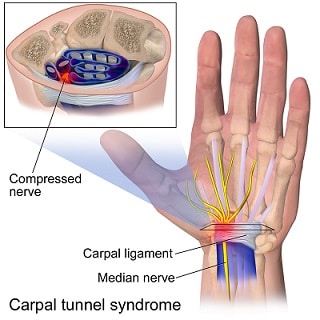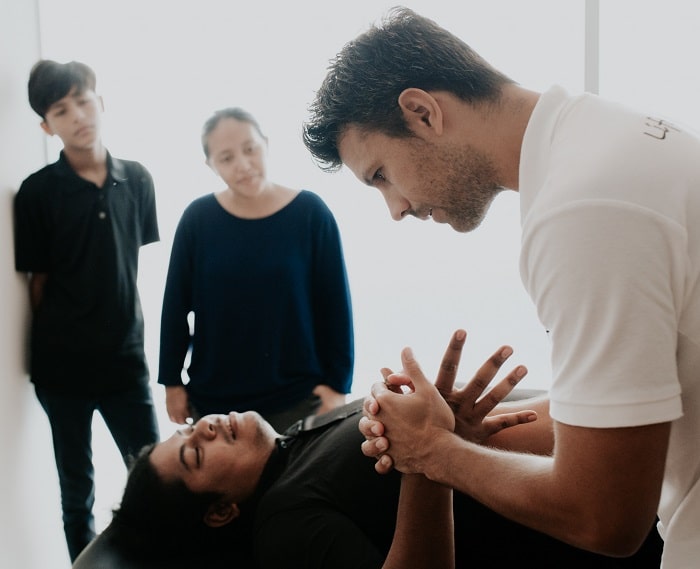Nerve pain in the hand | The carpal canal syndrome
Carpal canal syndrome is the most common condition affecting the nerves of the hand. Due to our lifestyle, more and more people suffer from it. What is it? What can osteopathy do about it?

Anatomy of the carpal tunnel
Blausen.com staff (2014). “Medical gallery of Blausen Medical 2014”
Anatomy of the carpal tunnel
The carpal tunnel is a narrow passageway in the wrist. The floor and sides of the tunnel are formed by small wrist bones called carpal bones. The roof of this tunnel is a strong band of connective tissue that is called the flexor retinaculum.
The carpal tunnel contains 9 tendons, and to the median nerve, which is one of the main nerve of the hand. The median nerve originates in the neck and goes down the arm and forearm. It passes through the carpal tunnel at the wrist, and goes into the hand. This nerve provides feeling in the four first fingers (from the thumb to the ring finger). Moreover, the nerve controls the muscles around the base of the thumb.
What usually goes wrong?
When the tunnel becomes narrower, or when the tissues start to become swollen, the pressure on the median nerve will be increased. As a result, patients might experience pain, numbness, tingling, and weakness in the hand. The pain can occur during day time, but night-time symptoms are also very common.
What are the main factors linked to carpal canal syndrome?

Carpal canal syndrome can be triggered by different pathology (such as diabetes), pregnancy or by repeating the same hand and wrist motions or activities over a prolonged period of time (such as working on computer, using a smartphone etc). Many patients find that moving or shaking their hands helps relieve their symptoms.
Although it is a gradual process, for most people carpal tunnel syndrome will worsen over time without some form of treatment. If diagnosed and treated early, the symptoms of carpal tunnel syndrome can often be relieved without surgery.
How can osteopathy help patients who suffer from carpal canal syndrome?
 Your osteopath will improve the function of your body all along the nerve by increasing the mobility of the different structures (joints, muscles..). Indeed, as said above, the median nerve originates in the neck and goes down the arm and forearm. It passes through the carpal tunnel at the wrist, and goes into the hand. Therefore, your osteopath will have to ensure that the nerve is free to slide all along its path, from the neck to your hand. And as osteopathy is a holistic manual therapy, your practitioner will also check on your whole body in order to improve its general.
Your osteopath will improve the function of your body all along the nerve by increasing the mobility of the different structures (joints, muscles..). Indeed, as said above, the median nerve originates in the neck and goes down the arm and forearm. It passes through the carpal tunnel at the wrist, and goes into the hand. Therefore, your osteopath will have to ensure that the nerve is free to slide all along its path, from the neck to your hand. And as osteopathy is a holistic manual therapy, your practitioner will also check on your whole body in order to improve its general.




